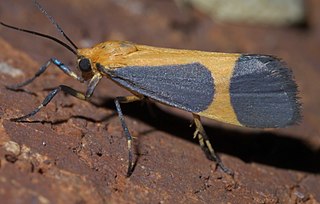
Cisthene is a genus of lichen moths in the family Erebidae. The genus was erected by Francis Walker in 1854.

Crambidia is a genus of moths in the family Erebidae. The genus was described by Packard in 1864.
Schinia carolinensis is a moth of the family Noctuidae first described by William Barnes and James Halliday McDunnough in 1911. It is found in the United States from eastern North Carolina to the Florida peninsula and probably along the Gulf Coast.
Coenochroa bipunctella, the sand dune panic grass moth, is a species of snout moth in the genus Coenochroa. It was described by William Barnes and James Halliday McDunnough in 1913, and is known from the United States, including Florida, Arizona and Maryland.
Macrorrhinia parvulella is a species of snout moth in the genus Macrorrhinia. It was described by William Barnes and James Halliday McDunnough in 1913 and is known from the US states of Florida and South Carolina. It is also found in Colombia.
Negalasa is a monotypic snout moth genus. Its one species, Negalasa fumalis, is found in the US state of Arizona. Both the genus and species were described by William Barnes and James Halliday McDunnough in 1913 in the same paper.
Acrolophus quadrellus is a moth of the family Acrolophidae. It was described by William Barnes and James Halliday McDunnough in 1913. It is found in North America, including Arizona.
Crambidia uniformis, the uniform lichen moth, is a moth of the family Erebidae. It was described by Harrison Gray Dyar Jr. in 1898. It is found from eastern North America, including Alabama, Florida, Georgia, Indiana, Iowa, Kentucky, Maryland, North Carolina, Ohio, Oklahoma, South Carolina, Tennessee and West Virginia.
Crambidia cephalica, the yellow-headed lichen moth, is a moth of the family Erebidae. It was described by Augustus Radcliffe Grote and Coleman Townsend Robinson in 1870. It is found in the central and southern part of the United States, from eastern Nevada, Utah and Arizona to southern Ohio, Tennessee, North Carolina and northern Georgia. The habitat consists of steppes and open forests.
Crambidia dusca is a moth of the family Erebidae. It was described by William Barnes and James Halliday McDunnough in 1913. It is found in North America, where it has been recorded from California and Ontario.
Crambidia impura is a moth of the family Erebidae. It was described by William Barnes and James Halliday McDunnough in 1913. There are two disjunct populations. It has been recorded from southern Rocky Mountain states, the Yukon and northern British Columbia and Alberta. The habitat consists of stabilized sand dunes dominated by open jack pine forests.
Cisthene conjuncta, the white-streaked lichen moth, is a moth of the family Erebidae. It was described by William Barnes and James Halliday McDunnough in 1913. It is found in southern Texas.

Cisthene picta, the pictured lichen moth, is a moth of the family Erebidae. It was described by William Barnes and James Halliday McDunnough in 1918. It is found in the United States from Texas to Arizona. The habitat consists of deserts.
Cisthene subrufa, the Tamaulipan lichen moth, is a moth of the family Erebidae. It was described by William Barnes and James Halliday McDunnough in 1913. It is found in the United States in Arizona and from San Benito, Texas south to Veracruz in Mexico.

Givira lucretia is a moth in the family Cossidae first described by William Barnes and James Halliday McDunnough in 1913. It is found in North America, where it has been recorded from Arizona, Texas and Wyoming.
Thaumatopsis floridella, the Floridian grass-veneer, is a moth in the family Crambidae. It was described by William Barnes and James Halliday McDunnough in 1913. It is found in North America, where it has been recorded from coastal areas in Florida, Georgia, Mississippi, New Jersey, North Carolina and South Carolina. It is also found in Cuba.
Glaphyria basiflavalis, the basal-dash glaphyria moth, is a moth in the family Crambidae described by William Barnes and James Halliday McDunnough in 1913. It is found in North America, where it has been recorded from Alabama, Florida, Mississippi and Texas.
Leptosteges flavifascialis is a moth in the family Crambidae. It was described by William Barnes and James Halliday McDunnough in 1913. It is found in North America, where it has been recorded from South Carolina to Georgia south into Florida.
Leptosteges sordidalis is a moth in the family Crambidae. It was described by William Barnes and James Halliday McDunnough in 1913. It is found in North America, where it has been recorded from Florida, Ohio, South Carolina and Ontario.
Sericosema immaculata is a moth in the family Geometridae described by William Barnes and James Halliday McDunnough in 1913. It is found in North America.



